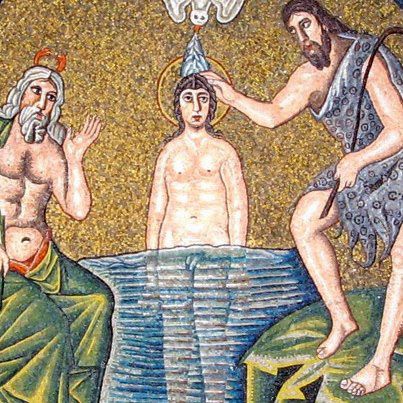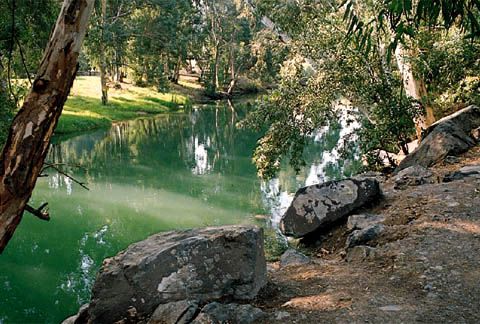MARY MAGDALENE - married to Jesus?
Do I believe that Mary and Jesus were married?
No I don’t.
And I’ll explain why.
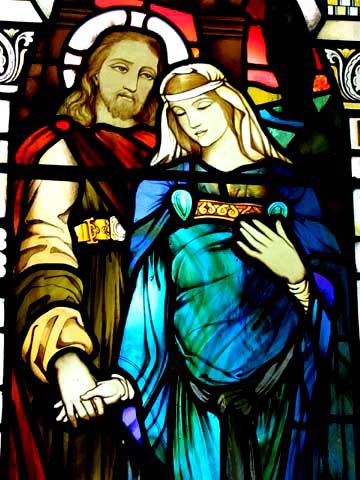
The well-known picture from a Scottish church, representing, by the right hands clasping, a marriage ceremony. It's also said that Mary was pregnant at the time.
We know from the Bible, now scholars have agreed that the Mary of Bethany and Mary Magdalene were the same person, that Mary washed Jesus’s feet with her tears, and dried them with her hair. Jesus was dining at the house of “Simon the Pharisee”, who omitted to offer him the chance to wash his feet, as it was customary to do in those days when a friend visited.
Simon was a “High Priest” - the Pharisees were the priestly caste of law-givers - so he and his family would have been well-off and educated. Those priests of the day presided over court cases for the affairs that were not in the concern of Roman justice.
It seems unlikely that this basic courtesy was not offered to Jesus. Could it be that Mary herself offered to do it and the event was later magnified by St. Luke, who described the incident? Luke was a follower of St. Paul and like St. Paul, had never met Jesus.
If Mary lived at Bethany, a suburb of Jerusalem, with her father and family, why was she described as the Magdalene, that is, a woman who came from Magdala?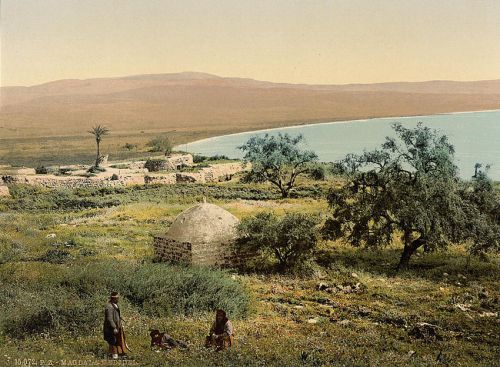 Magdala as it was in 1910
Magdala as it was in 1910
Magdala, on the shores of the Sea of Galillee, some miles away from Bethany, was known as the “Tower of Fish” because of the great concentration of the fishing industry there. By the time that Mary washed Jesus’s feet, she was known as the Magdalene, so she must therefore, have lived at Magdala for some time. Why should she have left her father’s house to go and live in Magdala? And why did she then leave Magdala to return to Bethany?
The answer came to me from a book that I ordered when I was researching the Arian religion in Ariège, the department next to Aude and Rennes-le-Château country. The book was a history of religion in the Pays de Sault, a region through which runs the Aude/Ariège border. It was a book of serious research, not a popularised or speculative book.
It said; Marie Madeleine était proche du Christ. Ce n’est plus, en 2000, la pécheresse de la tradition millénaire. Selon la version retransmise en Pays de Sault, Marie Madeleine quitta son mari, ce qui est une entorse grave à la loi juive, pour suivre la nouvelle loi. Suivre le maître dont elle fut la confidente et l’initiée.
This is so important that I have included the original French, in case anyone should dispute my translation, which is; Mary Magdalene was a close friend of Christ. She was no longer, in 2000, the sinner of the thousand year old tradition. According to the version re-told in the Pays de Sault, Mary Magdalene left her husband, which was a serious offence in Jewish law, to follow a new law. To follow the master of whom she was the confidante and the initiate.
I have often heard stories here in Languedoc that Mary Magdalene was married to a “fisherman.” That would be why she left her father, Simon, her sister Martha and her brother Lazarus in Bethany, because she had married, or her father had married her to, a fisherman in Magdala. It adds up.
Mary came from a wealthy middle-class family; her husband would not have been an ordinary fisherman, going out after dark in his own small boat to catch fish to sell at market like the fisherman disciples - he would have been a wealthy businessman.
However, I do not think she left her husband to follow Jesus. She left her husband before that. I think, bearing in mind the Jewish laws that we read about in the “Emancipated” article, that she wanted to leave her husband because he beat her. And so she came home.
In addition to that, she had lost her mother. In all the references to the house in Bethany in the Bible, a wife to Simon, or a mother to the three children, is never mentioned. When did she die? It seems to me that Mary could have had two reasons to come home.
Leaving her husband - a woman could not sue for divorce, remember - was considered a sin in Jewish law, an offence. It was almost unthinkable. The word for sinner used originally in the Gospel of Luke in the Bible was “harmartolos” - that is, one who offended against the Civil Law, rather than a moral sinner.
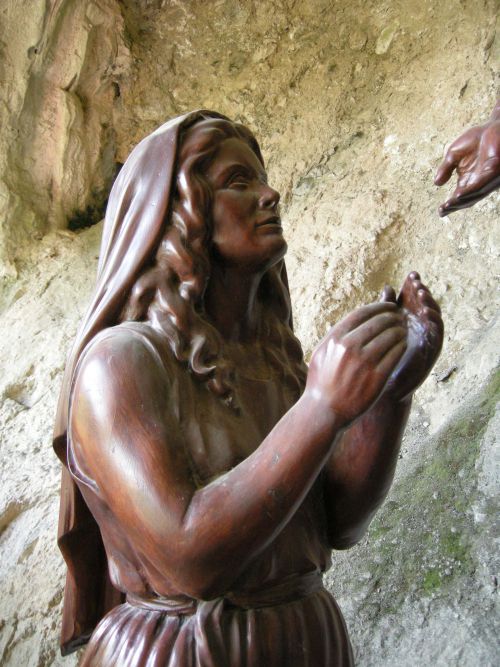 Jesus didn't condemn Mary. He held out a helping hand.
Jesus didn't condemn Mary. He held out a helping hand.
Luke calls Mary a sinner, he who had never met her, and only a few verses later Mary, called Magdalene, is described as the women who had had seven devils lifted from her and who had joined Jesus as a disciple in Capernaum. At the time diseases were thought to be caused by devils; the expression “casting out devils” meant healing. So what was the disease that Mary had? Some think it was epilepsy, but I believe she had what we would call a nervous breakdown, after the death of her mother and the disastrous marriage with a cruel man.
Whatever it was, she was healed before the feet-washing incident and before she joined Jesus at Capernaum. Did she already know him before he came to her father’s house?
I think she first saw him when Jesus was baptised by John the Baptist.
A 6th century representation with John the Baptist and a dove. The River Jordan as it is today.
This took place at the River Jordan not far from Bethany. It was an orchestrated event, for there had been some discussion over who should take the role of Messiah, John Jesus’s cousin, or Jesus. There were many people there, then John suddenly spotted in the crowd the one he knew immediately was the Messiah - what a coincidence!!!! Then John declared that Jesus was the Chosen One - the Messiah to save all Israel.
In those days baptism was whole body immersion, and the initiate had to be completely naked so the cold water could reach every part of the body to wash away all the sins.
Mary Magdalene was there at that ceremony. She saw the naked Jesus and fell in love with him.
So, we can now put together a chronology.
First Mary married, or was married to a businessman at Magdala at the age of - what? Fifteen? We know she lived there a while, to be called the Magdalene, so maybe she came home some 10 or 15 years later, unable to tolerate his cruelty any more.
Secondly, her mother had died and these two events of her life caused a breakdown, after what must have been terrible years for her.
Thirdly, she saw Jesus baptised and asked him to heal her, which he did. He had always been, and always was, a natural healer.
Fourthly, she persuaded her father to invite Jesus to their home. Then she became his disciple and lived with him and travelled with him everywhere. But Mary Magdalene and Jesus could not marry because she was already married and a woman could not divorce her husband.
So that’s my answer, technically they were not married but there’s no doubt they were “together” as we say today, because of the statements in the Gospel of Phillip that Jesus used to often kiss her and tell the disciples that he loved her.
So why did the Cathars of Ariège think that Mary and Jesus were married? This idea was unique to Catharism, the religion that arose in the mountain strongholds of the Corbières and Ariège. It’s my idea that the ancestors of the Cathars saw Mary and Jesus together as a couple and asssumed they were married.
Still today the French have only one word for “woman” and “wife” - femme.
Many researchers think that Jesus and Mary were married at the event described in the Bible as the Marriage at Cana. This story appears only in St John’s Gospel, Chapter Two, and the turning of the water into wine was considered to be Jesus’s first miracle. The story begins; Two days later there was a wedding in the town of Cana in Galillee. Jesus’s mother was there, and Jesus and his disciples had also been invited to the wedding.
Unlikely then that it was Jesus’s own, he was a guest, yet his mother complained to him that the wine had run out, and he took steps to replace it. The man in charge of the feast congratulated the bridegroom, saying it as a much better wine than had been previously served. The new wine was calculated as being 600 litres. It was therefore a very large wedding with many guests; almost a society wedding. At a litre per person that meant there were six hundred guests, but if the feasting took place over three days, as I’ve heard was the standard celebration for a Jewish wedding, then there were 300 guests - who had already drank the allotted wine dry on the first day!
We do not know whose wedding it was, but it seems to me it was the wedding of one of Jesus’s brothers.
Meanwhile, as soon as the question of being married arises among today’s researchers, so does the question of a Bloodline, and the existence of people alive today who are descended from Jesus. All this knocks on the head the idea that Jesus was celibate and non-sexual, which threatens the Roman Church, so there is much debate.
I cannot remember now where I first heard it or read it, but Mary and Jesus’s first child was a girl called Sarah, who was born at Rennes-les-Bains in September 33AD and later married the Lord of Râtis; the island that was once a Celtic oppidum at Stes. Maries de la Mer. Two thousand years ago the sandy swathe of land on which the town spreads itself did not exist, but the oppidum did, with its sweet water wells.
To see my article about Stes Maries de la Mer click here.
Inscrivez-vous au site
Soyez prévenu par email des prochaines mises à jour
Rejoignez les 261 autres membres

